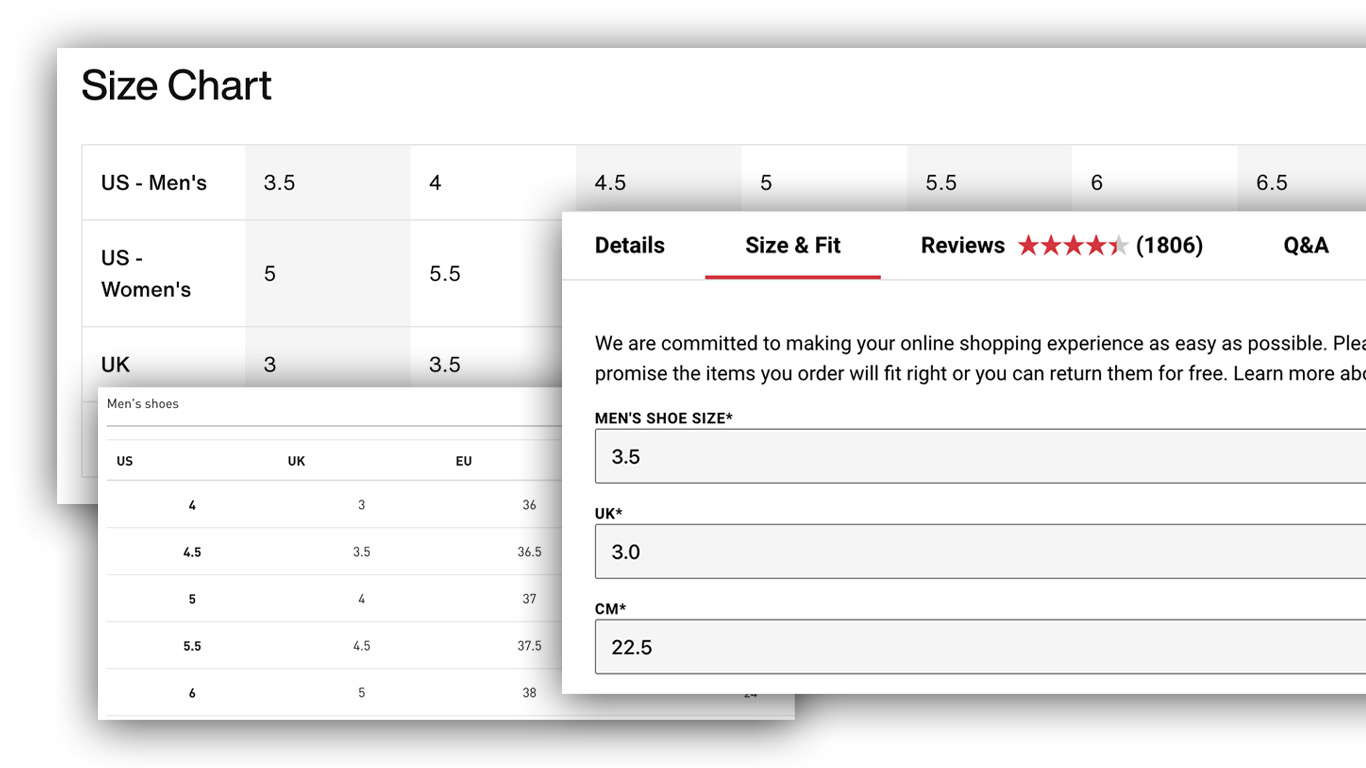Upgrading Size Charts for the Modern Shopper

Size charts have existed since the industrial revolution… And they haven't changed much since then! When you go shopping online anywhere, you'll see the same sort of size charts. They'll have a size conversion from US to UK and EU, (add in another country of your choosing). The brand will tell you their garments and footwear fit true to size, so, "just get your normal size". Are these ever useful? Do consumers ever believe they will fit true to size?
Why Are Size Charts So Bad?
In short, they are confusing. Sizing is complex, so charts have to decide between not giving the shopper enough information and complete information overload.
Steve Madden's Footwear Size Chart
They show an inches/cm measurement which is good- but what is it measuring?
Example Size Chart:
US 8 = UK 7 = EU 41 = 25.4cm
❌ Unclear what measurement represents
BRUNT Workwear's Size Chart
Their width recommendation is note-worthy.
Example Size Chart:
M 32 = Chest 32" = Width: Regular
✅ Includes width information
It's the same for all types of retailers: from Zara to Gucci, from Brunt Work Wear to Steve Madden. You're viewing size charts which are not useful and are thus glanced over in the consumer journey.
How do we make them useful?
1. Add ideal customer measurements ranges
E.g: For a foot that is between 23.1cm and 23.6cm long, we would recommend a size M6 / W7.5.
✅ Improved Size Chart:
Foot Length: 23.1cm - 23.6cm
Recommended Size: M6 / W7.5
✅ Clear measurement ranges
The first step is to add measurement ranges. These should ideally be the customer's measurements- not garment or footwear measurements. Either way, it should be marked clearly what the measurements are for.
These need to be ranges, such that the customer is not confused as to which size they fall into.
2. Make the size charts unique to the products
This shoe fits big, so the size guide has been adjusted to reflect this. The foot lengths are adjusted, and it is clearly communicated to the shopper.
✅ Product-Specific Chart:
Note: This shoe runs large
Foot Length: 22.8cm - 23.3cm
Recommended Size: M5.5 / W7
✅ Adjusted for product fit
If the size chart is the same on every single product of that type, your shoppers will think it's a generic size chart and is not useful for the specific product they are interested in.
Use your product team's insight, your customer feedback, your in-store team's feedback and your returns to adjust the size charts for your most popular products.
Your customers will have added confidence that they are viewing a size guide which is relevant and will be more likely to get their correct size the first time.
3. Account for width (or other hidden dimensions in apparel)
The T-Clip runs narrower, so shoppers are advised to size up if they have narrow feet.
✅ Width-Adjusted Chart:
Note: This shoe runs narrow
Recommendation: Size up if you have wide feet
Foot Length: 23.1cm - 23.6cm
Recommended Size: M6 / W7.5
✅ Width considerations included
Some shoes run narrow, and people with wider feet have to size up to accommodate their width.
You will be able to get this information at a product level from your returns, reviews, and from in-store staff feedback.
4. Automate shopper measurement gathering
Shoppers can see their measurements, their toe space in each size, and adjust their fit based on their preferences.
✅ Digital Sizing Tool:
Your Measurements: Foot Length 23.4cm
Recommended Size: M6 / W7.5
Toe Space: 0.8cm (Perfect)
✅ Personalized recommendations
Some customers will know their measurements. Others will be able to accurately measure themselves or have a friend measure them. For everyone else, you need a way to give them their measurements easily.
This is where a digital scanning tool like StrutFit comes in. Shoppers can easily scan and get their measurements, as well as their size in each of your items.
We want to do this… but it seems like a lot of work!
This is all great, but this is a lot of data. Where do you manage all this sizing data? You could try squeeze it into a PIM, but it's not going to be easy.
StrutFit's Solution
Fortunately, StrutFit have created a size chart management system which makes all of this work a breeze.
Here's a quick view into it:
StrutFit's Retailer Portal:
You can manage your products, size charts, and their associations easily here.
You can manage your charts, your products, and see all your sizing based sales and returns data- all in one place!
To learn more about how we can help you solve sizing Contact us.
Share this article
Ang Nayyar
CEO
Related Articles

Are Shoe Retailers Destroying Customer Experience With Inadequate Sizing Solutions?
High return rates plague the footwear industry, with online returns at 20.5% and in-store returns at 10.5%. Learn how inadequate sizing solutions impact customer loyalty and discover StrutFit's game-changing solution.
Read Article
The story behind Philos - a female-first running brand
StrutFit's CEO, Ang Nayyar, met up with Greg Rosborough to discuss his new female-first running brand- Philos. Learn about the inspiration behind this visually striking brand and their unique approach to running.
Read ArticleReady to Transform Your Retail Experience?
See how StrutFit's AI-powered solutions can help you achieve results like the ones we've discussed.